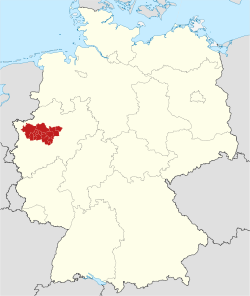Ruhr
The "Scots" that wis uised in this airticle wis written bi a body that haesna a guid grip on the leid. Please mak this airticle mair better gin ye can. (December 2023) |
The Ruhr (German Ruhrgebiet, colloquial Ruhrpott, Kohlenpott, Pott or Revier), is an urban area in North Rhine-Westphalie, Germany.[3] Wi 4435 km² an a population o some 5.2 million (2009), it is the lairgest urban agglomeration in Germany. It consists o several lairge, umwhile industrial ceeties bordered bi the rivers Ruhr tae the sooth, Rhine tae the wast, an Lippe tae the north. In the Southwest it borders tae the Bergisches Land. It is considered pairt o the lairger Rhine-Ruhr metropolitan region o mair nor 12 million fowk.
Ruhr Metropolitan Region Metropolregion Ruhr | |
|---|---|
 map o the Ruhr metropolitan region athin Germany | |
| Kintra | |
| State | |
| Maistmuckle cities | Dortmund Essen Duisburg Bochum |
| Govrenment | |
| • Bodi | Regionalverband Ruhr |
| Area | |
| • Metro | 4435 km2 (1,712 sq mi) |
| Highest elevation | 441 m (1,447 ft) |
| Lowest elevation | 13 m (43 ft) |
| Population | |
| • Metro | 5,172,745 |
| • Metro density | 1646/km2 (4,260/sq mi) |
| Time zone | UTC+1 (CET) |
| GRP | 2007 |
| Nominal | € 136.3 billion[1] |
| Website | www.metropoleruhr.de |
Syne the Ruhr is polycentric, coordinates shawn are general in natur an sae can be uised tae focus on the entire region o the Ruhr: 51°30′N 7°30′E / 51.500°N 7.500°E.
Frae wast tae east, the region includes the ceeties o Duisburg, Oberhausen, Bottrop, Mülheim an der Ruhr, Essen, Gelsenkirchen, Bochum, Herne, Hagen, Dortmund, an Hamm, as weel as pairts o the mair "rural" destricts Wesel, Recklinghausen, Unna an Ennepe-Ruhr-Kreis. Historically, the wastren Ruhr towns, siclik Duisburg an Essen, belangit tae the historic region o the Rhineland, whauras the eastren pairt o the Ruhr, includin Gelsenkirchen, Bochum, Dortmund an Hamm, wur pairt o the region o Westphalie. Syne the 19t century, thir destricts hae grown thegither intae a muckle complex wi a vast industrial landscape, inhabitit bi some 7.3 million fowk (whan includin Düsseldorf an Wuppertal). It is the fowert maistmuckle urban area in Europe efter Moscow, Lunnon an Paris.
For 2010, the Ruhr region wis ane o the European Caipitals o Cultur.
Notes
eedit- ↑ metropoleruhr.de
- ↑ heichest: Wengeberg in Breckerfeld, lawest: Xanten
- ↑ "Few foreigners know that in fact 'the Ruhr' is the name of a 150-mile-long Rhine right-bank tributary which, after meandering through the industrial basin now named after it, enters its parent near Europe's greatest inland port, Duisburg." See German International, Volume 10 (1966), p. 30. "The territory through which the Ruhr flows is called the Ruhr district." See Edmund Jan Osmańczyk and Anthony Mango, Encyclopedia of the United Nations and International Agreements: A to F, 2003, p.1970. "Many industries were built in the Ruhr region, where both iron ore and coal were found." Kathryn Lane, Germany: The Land (2001), p. 24.
References
eedit- Botting, Douglas (1985). From the Ruins of the Reich: Germany 1945–1949. New York: Crown Publishing. ISBN 0-517-55865-3.
- Bishop, Patrick. Bomber Boys Fighting Back 1940–1945
- French Directorate for Economic Affairs, Memorandum on the separation of the German industrial regions Archived 2011-08-09 at the Wayback Machine, 8 September 1945.
- Gareau, Frederick H. "Morgenthau's Plan for Industrial Disarmament in Germany", Western Political Quarterly, Vol. 14, No. 2 (Jun., 1961), pp. 517–53 in JSTOR
- Yoder, Amos. "The Ruhr Authority and the German Problem", Review of Politics, Vol. 17, No. 3 (Jul., 1955), pp. 345–358 in JSTOR
Forder readin
eedit- Kift, Roy, Tour the Ruhr: The English language guide (3rd ed., 2008) (ISBN 3-88474-815-7) Klartext Verlag, Essen [1] Archived 2022-05-22 at the Wayback Machine
- Berndt, Christian. Corporate Germany Between Globalization and Regional Place Dependence: Business Restructuring in the Ruhr Area (2001)
- Crew, David. Town in the Ruhr: A Social History of Bochum, 1860–1914 (1979) (ISBN 0231043007)
- Fischer, Conan. The Ruhr Crisis, 1923–1924 (2003)
- Gillingham, John. "Ruhr Coal Miners and Hitler's War", Journal of Social History Vol. 15, No. 4 (Simmer, 1982), pp. 637–653 in JSTOR* Chauncy D. Harris, "The Ruhr Coal-mining District", Geographical Review, 36 (1946), 194–221.
- Gillingham, John. Industry and Politics in the Third Reich: Ruhr Coal, Hitler, and Europe (1985) (ISBN 0231062605)
- Pounds, Norman J. G. The Ruhr: A Study in Historical and Economic Geography (1952) online
- Pierenkemper, Toni. "Entrepreneurs in Heavy Industry: Upper Silesia and the Westphalian Ruhr Region, 1852 to 1913", Business History Review Vol. 53, No. 1 (Spring, 1979), pp. 65–78 in JSTOR
- Royal Jae Schmidt. Versailles and the Ruhr: Seedbed of World War II (1968)
- Spencer, Elaine Glovka. "Employer Response to Unionism: Ruhr Coal Industrialists before 1914" Journal of Modern History Vol. 48, No. 3 (Sep., 1976), pp. 397–412 in JSTOR
- Spencer, Elaine Glovka. Management and Labor in Imperial Germany: Ruhr Industrialists as Employers, 1896–1914. Rutgers Varsity Press. (1984) online
- Todd, Edmund N. "Industry, State, and Electrical Technology in the Ruhr Circa 1900", Osiris 2nt Series, Vol. 5, (1989), pp. 242–259 in JSTOR
Freemit airtins
eedit| Wikimedia Commons haes media relatit tae Ruhrgebiet. |